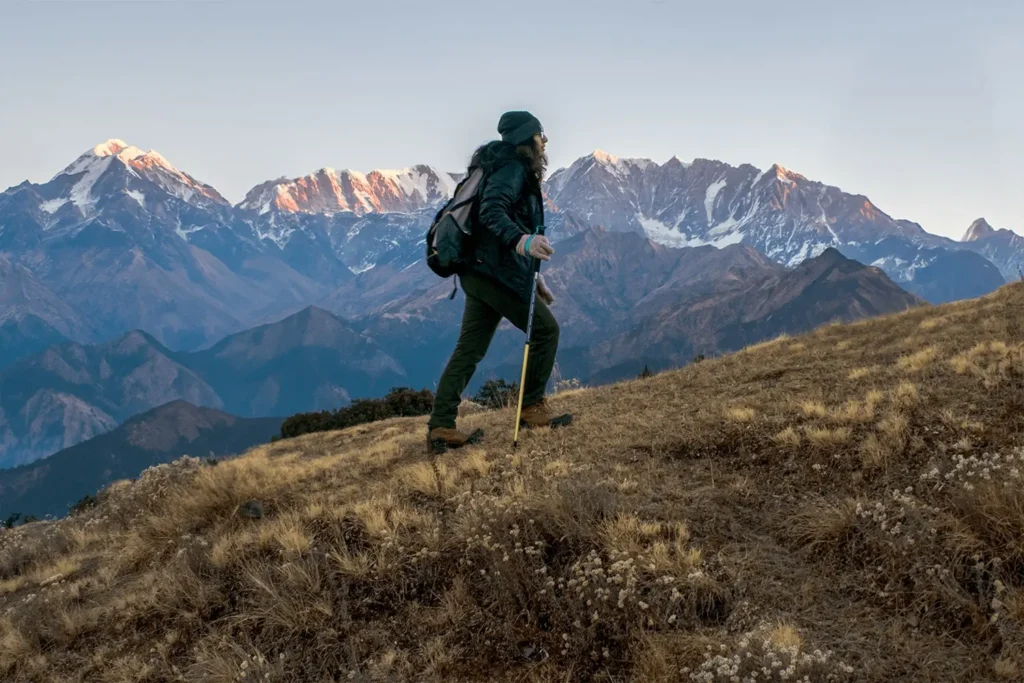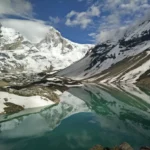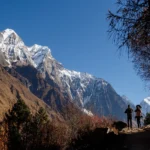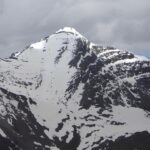Trekking in the Himalayas is often full of doubts. Am I well prepared physically, have I packed the required clothes? Will it be comfortable to walk on difficult terrain? Will the cold be bearable? The list of questions about how to prepare for winter treks is never-ending.
Trekking in the Himalayas during the winter months is enticing but also poses several challenges if not well prepared. Trekking in winter becomes trickier due to chilly weather and harsh weather conditions. Whether you are a beginner or a pro in the outdoor world, there are certain rules you should adhere to when you are heading on a Himalayan winter trek.
From exercising to layering up, let’s delve into what will prepare you for your next winter adventure in the Himalayas. Here is a list of all the factors you should keep in mind before signing up for a Himalayan Winter trek:
- Physical fitness
- Choosing the right trek
- Right gear
- Preparing yourself mentally
- Food preparation
- Acclimatization
- Clothing
- Sleep and rest
- Stay connected and aware
- Additional accessories
1. Physical Fitness
It is a given that a person has to be physically fit for the trek. And trekking in the snow? You might have to double those workout hours! You are conditioning your body to be well-prepared for the rigorous climb you will face on your trek while working out. Deep snow, large packs, and the frigid temperatures of the Himalayas are just a few of the reasons why winter trekking is more challenging than summer trekking.

Prepare by increasing your fitness level. Start your physical fitness preparation a minimum of 2 months before the trek. and you’ll have a lot more fun. Because your feet are heavily used while trekking, it is critical to develop your lower body and strengthen your lower body muscles. Indulge in knee-strengthening exercises to trek comfortably on a Himalayan winter trek.
Running, in the same way, is the initial step for someone who is new to the whole affair. The more you run, the more toned and capable your legs will become.
Strength training and aerobics should go hand in hand. The air grows thinner as we climb higher altitudes on the Himalayas. We need to improve our aerobic fitness to cope with declining oxygen levels.
2. Choosing the Right Trek
Trek planning includes choosing the right trek. For example, if you are new to trekking and directly opt for an advanced-level trek rather than a beginner one, you will likely have to back out mid-trek, exhausted and frustrated. Winter treks are more difficult because of the bone-chilling cold in high-altitude places and trudging through thick layers of snow. While it is wonderful to choose an adventure that will test you, make sure you have the necessary experience and are physically and emotionally prepared before making your decision.
Therefore, you should research thoroughly before you choose a trek and ask other experienced trekkers for advice too. Some examples of treks are:
- Easy: Dayara Bugyal Trek
- Moderate: Kashmir Great Lakes Trek
- Difficult: Rupin Pass Trek
3. Right Gear
Buying the right trekking gear is one of the most crucial elements that will help you on a winter trek in the Himalayas. Look out for these factors when you buy:

- Footwear – Should be waterproof/resistant. Weight should be Light but should have good traction.
- Backpacks – A backpack should not weigh more than 12 Kg, even for a long trek of 9/10 days. Always buy a rucksack with an adjustable shoulder strap and a hip/waist belt.
- Crampons – For steep slopes
- Goggles – To protect eyes from shining sunlight. This can cause snow blindness.
- Gaiter and pole: Snow will not enter your snow trekking shoes if you wear gaiters. The pole not only makes it easier to hike up in the snow but also aids in route navigation. Since the Himalayas are laden with snow in winter, mid-knee gaiters are best. These gaiters will keep your legs warm and dry in deep snow. For these gaiters, durability and waterproofing are critical requirements.
4. Preparing Yourself Mentally
Mentally preparing for a Himalayan trek is crucial since believing in your ability to complete a trek is what will ensure that you complete it. The majority of trekking is a mental battle in which your mind pushes your body to go the extra mile. In summary, your attitude is everything; a positive attitude may make or break your journey and alter your perspective on the process.
A few steps you can take to mentally prepare yourself are:
- Setting the correct expectations – knowing that a trek is a whole different experience with a lot of new things to see and do.
- Be Mentally Strong but make space for Flexibility – People are frequently harsh on themselves for being fatigued and falling behind the group. Know that trekking is a spiritual experience that is far from competition. On any trek, no two people share the same experience.
- Expect the unexpected – Although being physically prepared is essential, it is also necessary to stay mentally strong and calm comes what may. Be it bad weather, an unexpected injury, etc. no trek is perfect and one must be prepared for it mentally.
- Meditating can help you gain clarity and quiet your mind, and it’s a discipline you can start even as you prepare physically for the trek months ago.
5. Food Preparation
Before you go on your next winter trek in the Himalayas, make sure you pack sensibly and bring enough nutrition for your body. Since your body will get tired by trying to keep itself warm, it needs fuel to keep going. There are a variety of ways to gain the nutrients you need for an Outdoor trip, but here are a few suggestions:
- Fruit snacks are wonderful for giving you the quick bursts of energy your brain needs, in addition to being sweet and delightful.
- Consume High-Carbohydrate foods, such as whole-wheat products. Because you will be exceeding altitude, your capacity to breathe in oxygen must be well balanced to avoid high altitude sickness.
- Choose granola bars with a Higher Fat content in the morning since fats slow digestion and improve energy generation throughout the day.
- Peanut butter is not only delicious on just about anything, but it also provides your body with essential nutrients. It’s High in Protein, which is a key building component for the body after vigorous exertion in the snow.
- It’s critical to prioritize your health and keep an eye out for the various colds that are circulating. One way to do this is to use Vitamin Supplements to prevent illness from occurring in the first place.
- Consumption of Dry Fruits enhances energy and stamina; also as they are rich in fiber which means better digestion and overall health.
6. Acclimatization
Acclimatization is the process through which a person’s body adjusts to a change in its surroundings. To truly accomplish a high-altitude trek, we must properly acclimatize and not rely on medications. Our bodies are marvellous machines that are built to naturally adapt. Acclimatization is a process that varies according to the individual body. Few people acclimatize quickly, while others take a little longer.
Here are some things you can do to adapt to the Himalayan cold:
- Even though you can walk faster, go slowly on approach days. This provides your body with the necessary time to acclimate to the new severe environment.
- Do not completely cover yourself. Allow your sense organs to detect the true conditions outside, but don’t be too brave and go without any protection. Protect your face, tonsils, fingertips, toes, and other sensitive areas from the cold wind. Always keep your forehead covered.
- Take hot garlic soups, and raw garlic, and stay active, but not too active (otherwise you will tire yourself out), to improve blood circulation.
- Do not immediately enter your Tents or Sleeping bags. Enjoy your leisure time. Investigate the area. Walks for acclimatization are recommended.
- Get enough Rest. It’s the most crucial factor. It is during this time when your body recovers and prepares for the following day/altitude.
7. Clothing
The weather can be particularly harsh. As you walk continuously for hours on a trek, your body will be warm, and you will not feel cold while trekking. Your body heat keeps you warm all day. The prickly winter gives you shivers down your spine as you arrive at the campsites as your body cools down.
Choosing the right clothing for your trek is of utmost importance to enjoy your trek to the fullest.
On any Himalayan winter treks, be it Kedarkantha Trek or Brahmatal Trek, the temperatures drop to negative numbers. Temperatures will range between 8 and 15 degrees Celsius during the day and might drop from 3°C to -5°C during the night. This implies that throughout the day, you may normally trek with only one or two layers on. Temperatures at night are sub-zero which means you would require at least 2-3 layers inside the tent in the sleeping bag and 4 layers when out in the open to keep you warm.
These layers are:-
- A pair of night-time thermals, two sweaters, a fleece jacket, and a padded jacket.
- Warm accessories are also required, such as a woollen cap, gloves, woollen socks (for the night), and a neck warmer.
8. Sleep and Rest
When trekking a multi-day winter trek in the Himalayas, a decent night’s sleep is a must. A bad night’s sleep can lead to a difficult day of trekking, which can lead to another bad night’s sleep – a vicious cycle you should avoid.
Keep these things in mind when it comes to sleep and rest preparation:
- Sleeping bag– One that isn’t overly heavy and keeps you warm at a lower temperature than you expect.
- Sleeping mattress- Choose an easy-to-carry sleeping mattress so that you don’t feel cold and wake up feeling revitalized.
- Pillow– A small pillow will do and if you want to save space, try folding your jacket and using it as one.
It is also helpful to stick to a sleeping schedule weeks before the trek. If possible, ask your trek guides about the rest schedules on the trek and practice accordingly.
While on the trek It will take time for your body to warm up the sleeping bag if you become cold within it. As a result, warming up before going to bed will be beneficial. It’s a good idea to warm up with activities like brisk walking or jumping jacks before getting into your sleeping bag. If you’ve just finished eating, don’t over-exercise.
9. Stay Connected and Aware
Exploring the Himalayas is enjoyable and might seem easy, but as a trekker, you must be well-educated and aware of the potential dangers. You must choose your adventure companions and your terrain carefully. If you’re going on a winter trek with a group of pals, be sure they’re all experienced hikers. It should always be in the back of your mind that if things go wrong on your trek, at least someone’s got your back.
Request a full itinerary, trek essentials, and other information from your trek operator, including where you’ll be, how long you’ll be there when you’ll return, where to go, and more. You must be aware of all pertinent details for the trek. Check that all of your equipment is in working order and that any necessary tools, such as first aid kits and matches, are stocked and available. While it’s good to go for walks and explore the areas alone, try not to go too far and always remain near your group in case things go wrong. Let someone know where you’re going and when you plan to be finished.
10. Additional Accessories
We may not be able to control the weather on the peaks, but we can certainly assist you in being prepared and carrying all of the necessary items. It is annoying if we pack all the major things and forget the small yet necessary ones.
Remember to carry these things on your Himalayan trek:
- Petroleum jelly/ lip balm: to keep your lips from chapping and bleeding
- Sunscreen: to protect your skin from the harmful UV rays up there
- Thermos flask: to keep your water hot
- Portable cutlery (preferably steel to avoid littering)
- Tissue rolls and sanitizers
- Talcum powder to resist fungal infection on toes
- Band-aids and doctor’s tape
- Accessories to keep body parts covered which lose heat rapidly like Balaclava, head cap, gloves, etc.
Conclusion
Everyone loves the snow but let’s face it, not everyone is prepared to venture into these rugged terrains in the Himalayas. With enough planning and being equipped with winter trek essentials, one can face challenges like unexpected route changes, injuries, and more. For example, if you are prepared with the right clothing and shoes for a winter trek, you won’t have to worry about the cold getting to you. If you know which food to pack for the Himalayas your body would waste less time digesting food that isn’t helpful on such treks.
Hence, you see the secret to a perfect trek isn’t just finishing it on time but planning it months before. We hope the above pointers will help you be the next trek angel on the Himalayas!
Let us know in the comments if you have anything to share on Winter Treks Preparedness.





